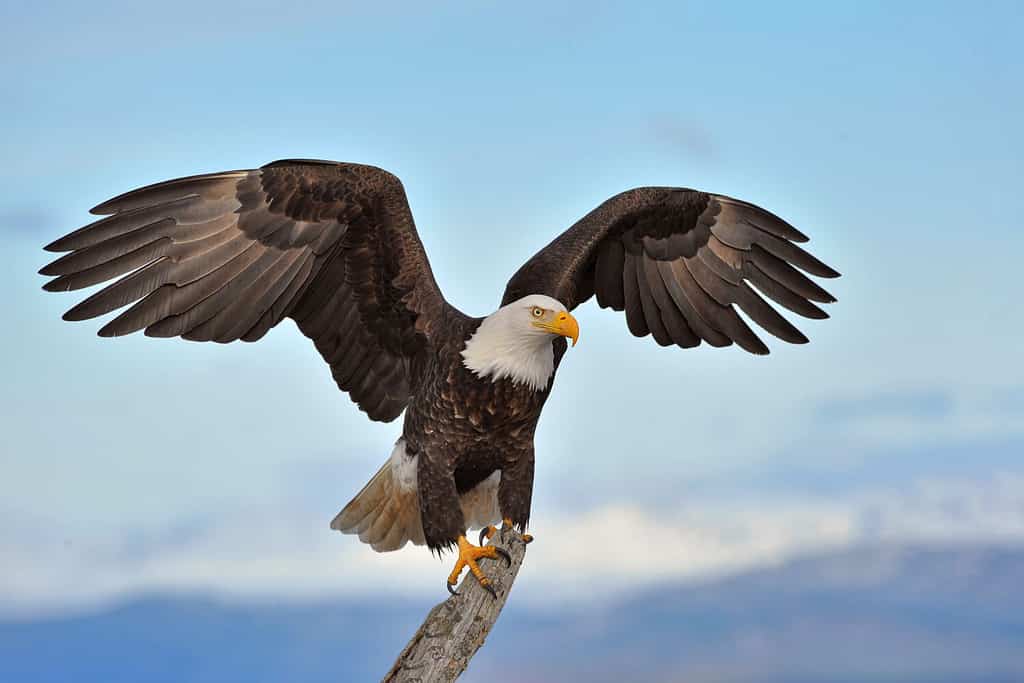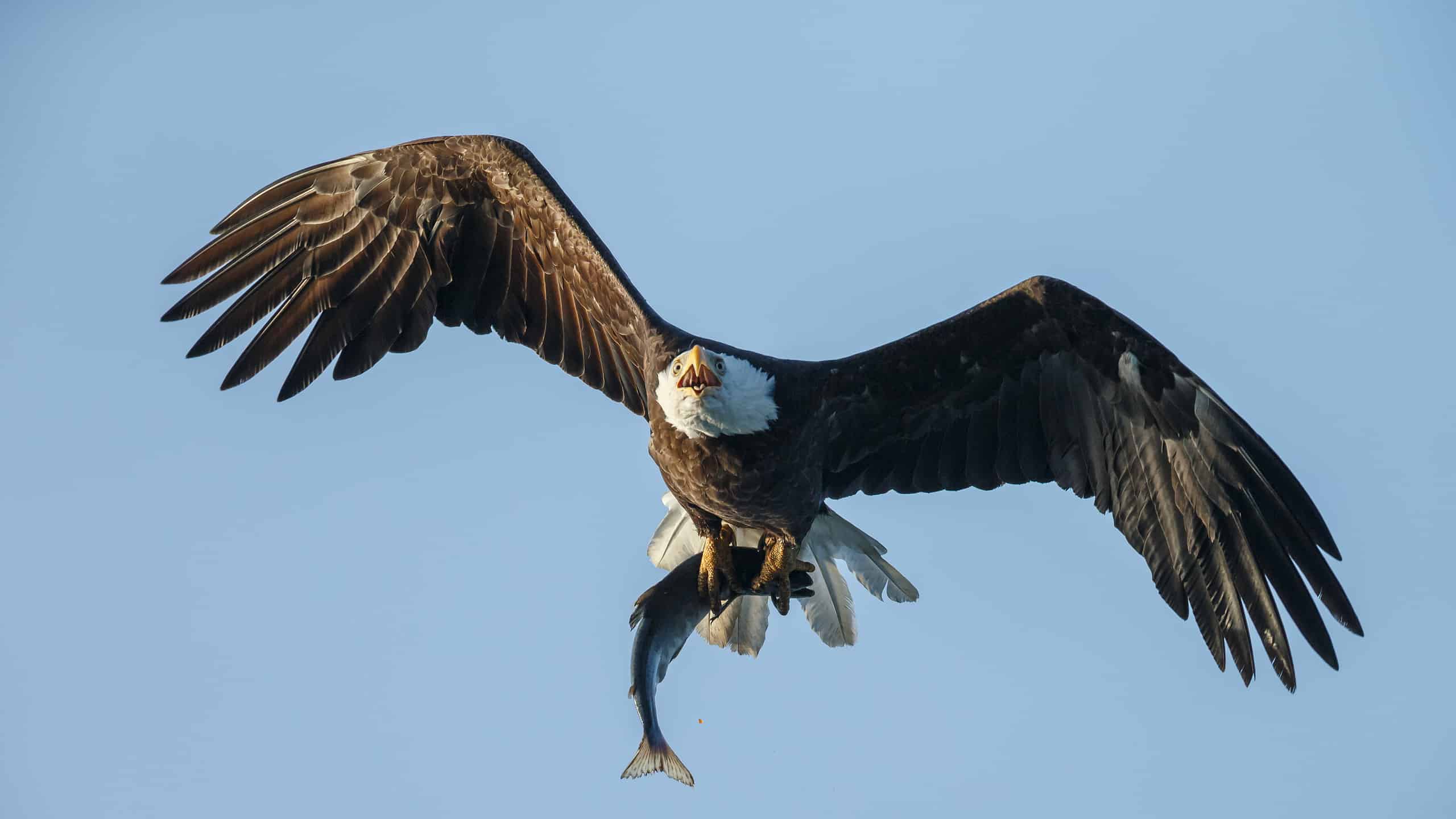When bad weather rolls in, eagles rise above the storm clouds. These majestic birds of prey are aerial champions, using air currents, their large wingspans, and strong muscles to soar to great heights. Staying at high altitudes is easy for the eagle, which has a respiratory system built for height. Moreover, these birds are fast, diving at speeds of 100 mph when swooping in for a meal. Just how high can eagles soar? Read along to find out.
How High Eagles Can Soar

Eagles will soar above stormy clouds to avoid the bad weather.
©FloridaStock/Shutterstock.com
Eagles soar up to 10,000 to 15,000 feet above sea level. They glide effortlessly by riding thermal air currents, conserving energy for important tasks like hunting and migrating. During migration, golden eagles have the ability to detect wind turbines. They adapt their altitude, solving the obstacles by flying over them. Eagles also soar above clouds to avoid extreme weather. They’re well adapted to flying in extreme weather conditions and can fly for hours without losing stamina.
Specialized Adaptations

Instead of nostrils, eagles breathe through the slits, or nares, on the sides of their beak.
©Radka Smach/Shutterstock.com
One of the reasons eagles can fly so high has to do with their efficient respiratory systems and specialized hemoglobin. Plus, their wing muscles have loads of blood vessels that help move oxygen around their body quickly and efficiently.
Eagles have large lungs that take in as much oxygen as possible. Bald eagles inhale air through two slits located near the top of their beak. These are called their external nares. The inhaled air enters their lungs and is directed into the air sacs. Then the air passes back through the lungs and exits through the nares.
Incredible Speed

Golden eagles can dive and swoop at speeds of 120 mph.
©Martin Mecnarowski/Shutterstock.com
Eagles can soar high and fast! Bald eagles fly close to the ground and snatch up their prey. Known for their powerful talons and heavy beaks, bald eagles usually fly around 20-40 mph. But during dives, they can accelerate to 100 mph. Golden eagles soar at around 30 mph, but they can glide at speeds up to 120 mph during hunting.
Eagles are considered raptors or birds of prey. Around 60 species of eagles are categorized into four groups based on their primary prey: fish, snakes, small mammals, birds, and reptiles. Bald eagles are big fans of fish, which make up most of their diet. But that’s not all they go for. These majestic birds are opportunistic eaters. They’ll go for whatever food is available and easy to get. Sometimes they eat ducks, geese, and even groundhogs.
Remarkable Strength

Carrying fish is easy for eagles, who can usually carry nearly half their body weight.
©Gregory Johnston/Shutterstock.com
On average, eagles can carry about half of their own weight. And females carry larger prey than males, depending on their size. Bald eagles typically have the capacity to carry around 6 pounds, but they’ve been observed lifting items weighing up to 10 pounds.
Sometimes eagles misjudge the weight of their prey. They might think they’re snatching up a reasonably sized snack, only to discover it’s past their carrying capacity. This can happen with all sorts of prey, especially fish. Young eagles are usually the ones to make this mistake. Swooping in for a tasty salmon, only to realize it’s much too big to carry.
The eagle’s carrying abilities are helpful when it’s time to build a nest. A bald eagle’s nest can weigh over 2,000 pounds. They build these huge nests on top of tall trees near rivers, lakes, and wetlands. If it’s a good nesting spot, they’ll return to it yearly and make it even bigger.
Humongous Wingspan

African fish eagles have a wingspan of roughly 6 feet; females are nearly 8 feet wide.
©Tomas Drahos/Shutterstock.com
Eagles can soar so high, thanks to their large wingspans. An adult eagle can have about 7,200 feathers. The largest eagle is the Martial Eagle from sub-Saharan Africa, boasting an 8.5-foot wingspan and a weight of around 14 pounds. Stellar’s sea eagle, found in East Russia, Japan, and South Korea during the summer, ranks second with an 8.3-foot wingspan, while the American bald eagles come third, with an 8.2-foot wingspan and an average weight of 17 pounds. Finally, African fish eagles have a wingspan ranging from 6.5 to 7.9 feet wide.
Thermal Updrafts vs. Orographic Updrafts
Eagles fly really high using two kinds of air currents: thermal updrafts and orographic updrafts. Thermal updrafts happen when the sun heats the ground, and the warm air rises. Eagles love thermal updrafts because they allow them to reach great heights without using too much energy. Eagles tend to fly higher in open areas like grasslands or valleys, where thermal updrafts are more common.
Orographic updrafts, on the other hand, occur when the wind hits mountains or hills and is forced to go up. These drafts are more about covering distance than reaching new heights. Eagles use these updrafts to glide far distances without having to flap a lot, which again saves energy. Eagles tend to fly lower in areas with mountains, using orographic updrafts to keep them in the air.
Thank you for reading! Have some feedback for us? Contact the AZ Animals editorial team.








